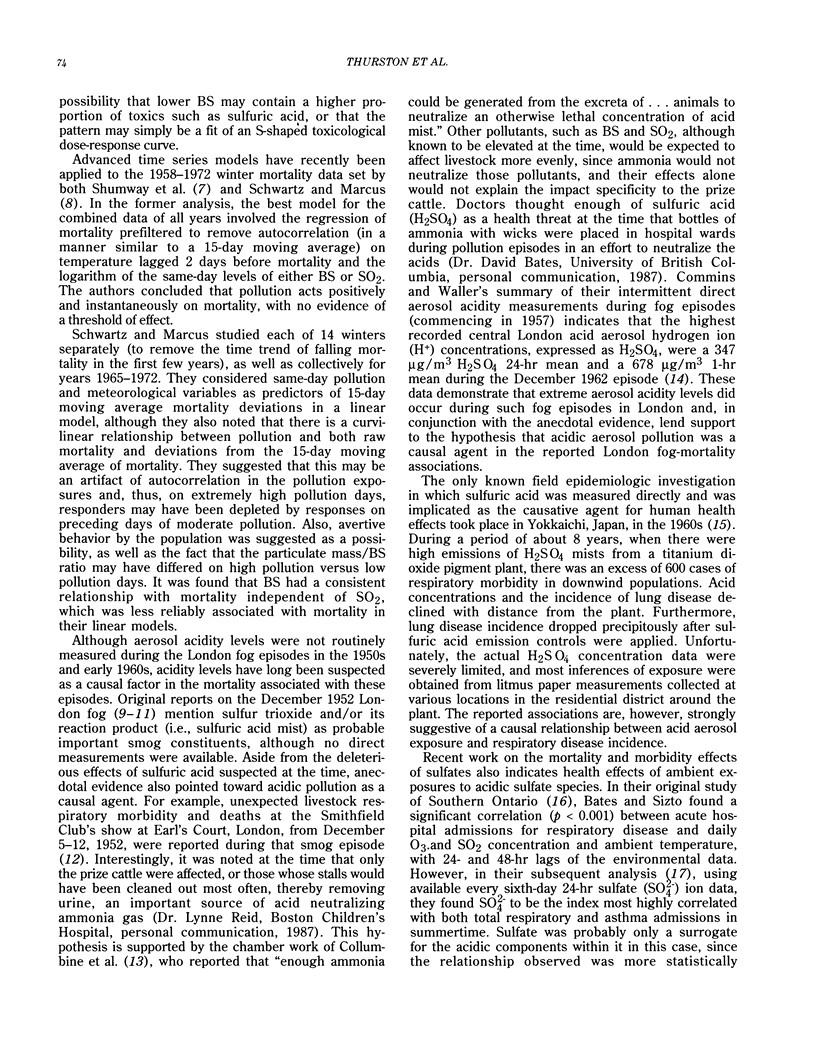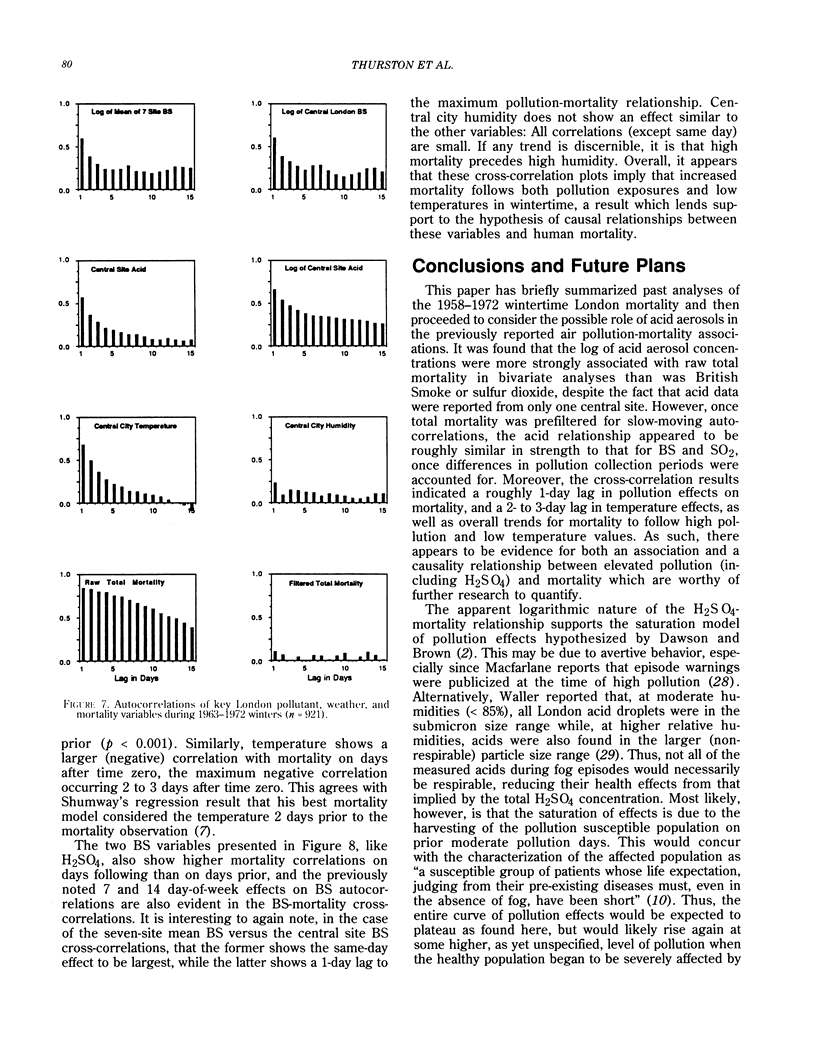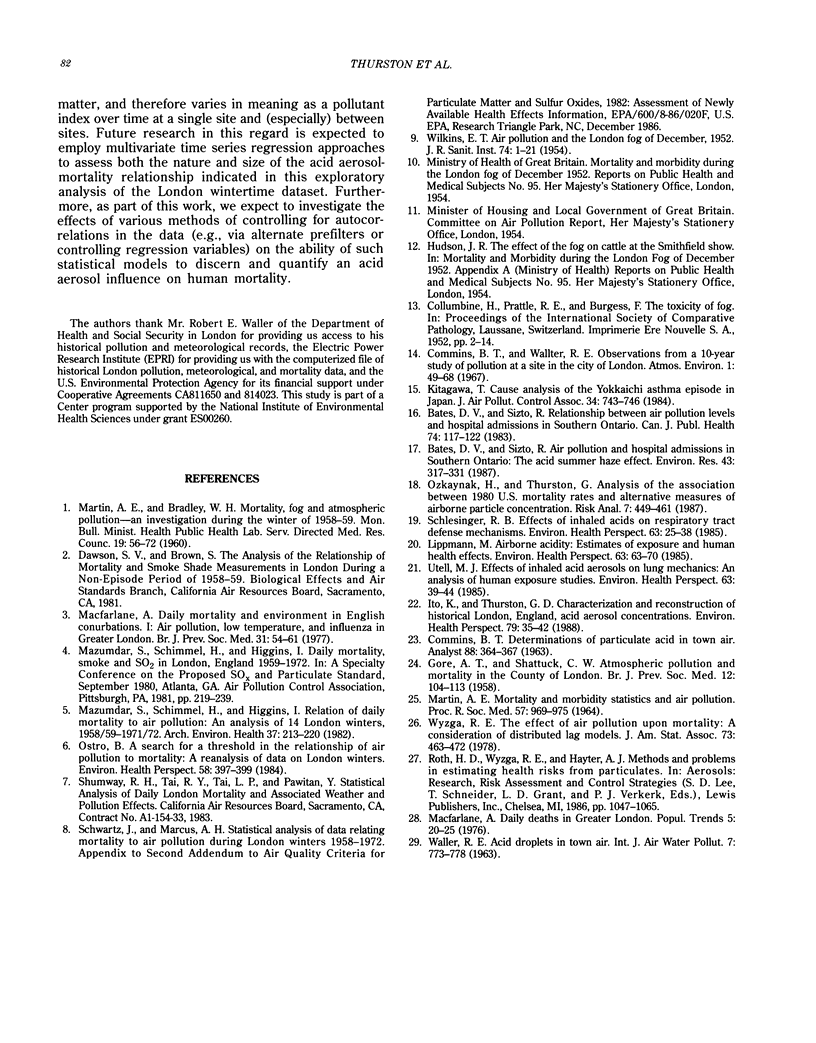Abstract
Air pollution epidemiology since the 1950s has been able to demonstrate that increases in daily mortality in London, England, were associated with elevated concentrations of index air pollutants, i.e., British Smoke (BS) and sulfur dioxide (SO2). In this work, we reanalyze that portion of the 1958-1972 winter mortality-pollution record for which daily direct acid aerosol measurements were made at a central site in London (St. Bartholomew's Medical College). The purposes of these exploratory analyses are to examine the dataset for indications of a relationship between acid aerosol pollution and human mortality and to compare any noted associations with those for other pollution variables. It is found that the log of acid aerosol concentrations is more strongly associated with raw total mortality in bivariate analyses than is BS or SO2, despite the fact that acid data are available from only one central site (versus seven disperse sites for BS and SO2). The logarithmic nature of the exposure side of the H2SO4-mortality relationship implies a saturation model of pollution effects, possibly due to multiday pollution harvesting influences on a susceptible subpopulation. Moreover, mortality-pollution cross-correlation analyses indicate that mortality effects usually follow pollution in time, supporting a causal relationship between the two. The apparent advantage of H2SO4 over BS in predicting total raw mortality is consistent with the hypothesis that it is the portion of particulate mass of greater health significance and may also allow the development of London mortality results which are more easily transferable to other environments than is the case for existing BS results.
Full text
PDF









Selected References
These references are in PubMed. This may not be the complete list of references from this article.
- Bates D. V., Sizto R. Air pollution and hospital admissions in Southern Ontario: the acid summer haze effect. Environ Res. 1987 Aug;43(2):317–331. doi: 10.1016/s0013-9351(87)80032-4. [DOI] [PubMed] [Google Scholar]
- Bates D. V., Sizto R. Relationship between air pollutant levels and hospital admissions in Southern Ontario. Can J Public Health. 1983 Mar-Apr;74(2):117–122. [PubMed] [Google Scholar]
- GORE A. T., SHADDICK C. W. Atmospheric pollution and mortality in the Country of London. Br J Prev Soc Med. 1958 Apr;12(2):104–113. doi: 10.1136/jech.12.2.104. [DOI] [PMC free article] [PubMed] [Google Scholar]
- Ito K., Thurston G. D. Characterization and reconstruction of historical London, England, acidic aerosol concentrations. Environ Health Perspect. 1989 Feb;79:35–42. doi: 10.1289/ehp.897935. [DOI] [PMC free article] [PubMed] [Google Scholar]
- Kitagawa T. Cause analysis of the Yokkaichi asthma episode in Japan. J Air Pollut Control Assoc. 1984 Jul;34(7):743–746. doi: 10.1080/00022470.1984.10465807. [DOI] [PubMed] [Google Scholar]
- Lippmann M. Airborne acidity: estimates of exposure and human health effects. Environ Health Perspect. 1985 Nov;63:63–70. doi: 10.1289/ehp.856363. [DOI] [PMC free article] [PubMed] [Google Scholar]
- MARTIN A. E., BRADLEY W. H. Mortality, fog and atmospheric pollution: an investigation during the winter of 1958-59. Mon Bull Minist Health Public Health Lab Serv. 1960 May;19:56–72. [PubMed] [Google Scholar]
- MARTIN A. E. MORTALITY AND MORBIDITY STATISTICS AND AIR POLLUTION. Proc R Soc Med. 1964 Oct;57:SUPPL–SUPPL:975. doi: 10.1177/003591576405710P202. [DOI] [PMC free article] [PubMed] [Google Scholar]
- Macfarlane A. Daily mortality and environment in English conurbations. Air pollution, low temperature, and influenza in Greater London. Br J Prev Soc Med. 1977 Mar;31(1):54–61. doi: 10.1136/jech.31.1.54. [DOI] [PMC free article] [PubMed] [Google Scholar]
- Mazumdar S., Schimmel H., Higgins I. T. Relation of daily mortality to air pollution: an analysis of 14 London winters, 1958/59-1971/72. Arch Environ Health. 1982 Jul-Aug;37(4):213–220. doi: 10.1080/00039896.1982.10667567. [DOI] [PubMed] [Google Scholar]
- Ostro B. A search for a threshold in the relationship of air pollution to mortality: a reanalysis of data on London winters. Environ Health Perspect. 1984 Dec;58:397–399. doi: 10.1289/ehp.8458397. [DOI] [PMC free article] [PubMed] [Google Scholar]
- Ozkaynak H., Thurston G. D. Associations between 1980 U.S. mortality rates and alternative measures of airborne particle concentration. Risk Anal. 1987 Dec;7(4):449–461. doi: 10.1111/j.1539-6924.1987.tb00482.x. [DOI] [PubMed] [Google Scholar]
- Schlesinger R. B. Effects of inhaled acids on respiratory tract defense mechanisms. Environ Health Perspect. 1985 Nov;63:25–38. doi: 10.1289/ehp.856325. [DOI] [PMC free article] [PubMed] [Google Scholar]
- Utell M. J. Effects of inhaled acid aerosols on lung mechanics: an analysis of human exposure studies. Environ Health Perspect. 1985 Nov;63:39–44. doi: 10.1289/ehp.856339. [DOI] [PMC free article] [PubMed] [Google Scholar]
- WALLER R. E. ACID DROPLETS IN TOWN AIR. Air Water Pollut. 1963 Oct;7:773–778. [PubMed] [Google Scholar]
- WILKINS E. T. Air pollution and the London fog of December, 1952. J R Sanit Inst. 1954 Jan;74(1):1-15; discussion, 15-21. [PubMed] [Google Scholar]
- Wyzga R. E. The effect of air pollution upon mortality: a consideration of distributed lag models. J Am Stat Assoc. 1978;73(363):463–472. doi: 10.1080/01621459.1978.10480035. [DOI] [PubMed] [Google Scholar]


